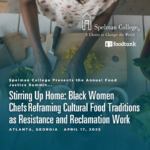Why do low-income, minority communities lack access to affordable, healthy food options? How does the modern food system threaten traditional Native American food sovereignty? What does it mean to be food insecure? These were some of the challenges and questions raised at the “Global Food, Local Solutions” conference held at Vermont Law School (VLS) earlier this year.
The daylong event featured several panels addressing food safety risks pertaining to low-income neighborhoods, Indigenous perspectives on food sovereignty, and food security challenges in New England.
“We wanted to highlight the challenges faced by many communities in the U.S. and internationally, and how we can work with various models of agriculture to help find solutions,” said Alona Tate, a juris doctor (JD) candidate at VLS and one of the event’s organizers.
Food insecurity and its associated health risks tend to disproportionately affect low-income communities of color. Panelist Jennifer Quinlan, a food microbiologist at Drexel University, pointed out that these communities typically lack access to healthy, nutritious food, and that the food they purchase from corner stores may have higher levels of bacteria and contaminants. Providing safer, healthier alternatives, such as urban farmers markets or community gardens, can improve both human health and community vitality.
Another important step is to find ways to reclaim Indigenous knowledge and sustainable practices as it relates to food and farming. As panelist Simone Senogles of the Indigenous Environmental Network explained, native people have long thrived through an interconnected and intimate relationship with the land, but the rise of modern agriculture and the corporate state disrupted and displaced that way of life.
“This control of our food, of the resources we need to survive, is a new form of colonization,” said panelist Sherri Mitchell, a native activist and attorney from Maine. Industrial expansion and exploitation, such as development of the tar sands in Alberta, Canada, has all but destroyed traditional subsistence food sources for native communities. But as Mitchell pointed out, unjust allocation of and access to resources no longer only negatively affect Indigenous people. The corporate assault on the environment, including food systems, has far-reaching consequences for average citizens. “All these things that have affected Indigenous people for so long are now spilling out into the commons,” said Mitchell.
One result of the corporatized system suppressing common people is increasing levels of hunger and food insecurity among working-class citizens. Low wages—combined with rising costs of living and decreasing access to affordable housing, public transit and local, healthy food sources—leads to greater food insecurity. In Vermont, for example, nearly half of working families struggle to make ends meet; 13 percent of households are classified as food insecure, according to Hunger Free Vermont.
“When we talk about food insecurity, we’re really talking about economic insecurity and poverty and access to a dignified life,” said panelist Faye Conte of Hunger Free Vermont.
Organizations like Connecticut-launched Wholesome Wave are working to change this through programs aimed at increasing affordability and access to local, nutritious food for all people regardless of income. Through initiatives such as the Double Value Coupon Program and the Fruit and Vegetable Prescription Program, Wholesome Wave makes fresh, local food available in underserved communities.
Despite these positive steps, food insecurity remains a pressing issue, not only in New England, but nationally and globally. The final panel, featuring Vermont Law professor Jamie Renner and the Foreign Agricultural Service’s Jocelyn Brown, reflected on this broader picture of food security. Renner argued that the public could view global food insecurity through a law and policy lens, while Brown pointed out the value of genetic engineering in providing food to a booming world population.
Overall, the conference made it clear there is no easy fix to building a more just food system, particularly given the twin challenges of climate change and population growth. Solutions must come from a variety of approaches, from local and community programs, to law and policy overhaul, to technological innovations.
“I was most struck by what Jocelyn Brown of the Foreign Agriculture Service said when she encouraged us give pause to think about genetically engineered crops, and consider the ways that genetically modified seeds can actually decrease our environmental degradation,” Tate, reflecting on the conference panels, said. “Additionally, she mentioned that with a growing world population, in our foreseeable future, there simply will not be enough food if we don’t think outside of the box to find solutions.”













